By Jeffrey A. Rendall, Images courtesy of Bridgestone Golf
COVINGTON, GA – Spin. It’s something that everyone talks about in golf, yet something that’s decidedly impossible for the average player to sense or measure.
It’s also the thing that largely determines how your golf shots perform. With drivers, too much spin is a bad thing – and in the case of side-spin, it can be a shot-killer.
That’s why the Bridgestone J40 430 driver is better than other drivers that have come before, according to the company’s Golf Club Marketing Manager, Josh Kinchen. “Without question, what separates the J40 430 driver from the competition is the club’s ability to kill spin. It is more about the sum of the parts than any one specific design element, but the J40 430 is easily one of the lowest spinning drivers on the market.”
Kinchen continues, “This means less backspin is generated at launch, leading to a more penetrating trajectory with increased roll. The J40 430 also provides the clean, classic appearance at address that most Tour players prefer: smaller, pear shaped head with a square face and no “gimmicky” alignment aids to get in the way of pure performance. Simply put, for the right player, this is one of the longest and most workable drivers available on the market today.”
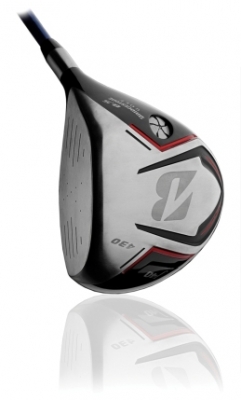 |
There’s little doubt, the J40 430 is a bit of a throwback in terms of traditional looks. With drivers coming out these days in practically every shape, size and color, the Bridgestone version is rather “normal” in the aesthetic sense.
Similarly, it lacks the space-age doohickeys of adjustable drivers, which also bucks the current trends. According to Kinchen, that was by design: “Our research has shown us that nearly 95% of all players with an adjustable driver rarely, if ever, change the setting from their initial fitting.”
“With this in mind, we guided our attention away from adjustability, and rather decided to focus on making a driver that set itself apart with its performance alone. In doing so, we realize that we didn’t make a driver for everyone, but that’s ok. The product we brought to the market fits the niche of the player looking for pure spin killing distance with the clean, classic look that has stood the test of time.”
Niche marketing, perhaps. But it’s refreshing to hear a company representative admit that their product may not be for everyone.
Like all newer-vintage drivers, there’s a lot of ‘stuff’ going on inside the head in terms of materials. The J40 430 (and 445) driver is constructed of 6-4 titanium, with a 4-piece club head that allowed Bridgestone the ability to modify the weight distribution for enhanced forgiveness on mis-hits and deep distance with spin reducing characteristics at launch. The face of the J40 driver is constructed in a way to provide maintained ball velocity on off-center hits due to its unique inner “starfish” construction pattern that increases face thickness along the outer edges.
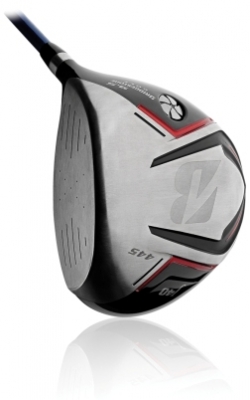 |
Ah, the face. It appears larger than most drivers – or at least “taller.”
Kinchen explains: “Both J40 drivers were designed with a deeper face. This allows us to use the larger volume heads and receive the benefits of increased forgiveness, without having them appear to be as overwhelming as some of the other drivers available on the market. In addition, a deeper face is designed to create a slightly higher center of gravity that keeps the ball from ballooning.”
“Pairing the deep face design with our variable hosel lengths allowed us to optimize the center of gravity on both the 445 and 430 models to fit the niche we were targeting. The 445 is for the player looking for the highest launch, lowest spin, and straightest trajectory. The 430 is for the player looking for more traditional shaping with slightly lower trajectory and increased shot-shaping performance.”
Other differences between the two models -- the J40 445’s head is designed in a more traditional round shape with a very deep face and is obviously slightly larger overall than the 430. The 445 also has a shorter hosel than the 430 model. The J40 445 is more forgiving as a result, and will typically launch higher with less spin than the J40 430 model.
The 430 model has a slightly longer hosel than the 445 to promote a slightly lower launch that better players typically prefer. Overall, the J40 430 still provides deep distance with its low spin profile, but features a smaller head shape that allows for increased workability.
 |
J40 Irons
Bridgestone’s J40 franchise also includes irons, beautifully crafted forged clubs that boast the hard-to-beat quality of Japanese manufacturing.
Coming on the heels of the Bridgestone J38 products, I wondered how they were “new and improved” over the previous models. Again, Kinchen offers the answers. “The J40 Dual Pocket Cavity Irons build on the same innovative weight management system introduced by its predecessor, the J38 DPC.”
“The biggest difference is that the J40’s revamped dual pocket cavity provides increased Tour Stability by moving more discretionary weight to the perimeter, creating even higher MOI than the previous version. Another difference is the improved leading and trailing edge relief that helps prevent digging in softer conditions and helps in cutting through the thicker rough.”
Having never tried the J38’s, I can’t speak to any personal impressions in terms of performance differences from the previous edition. I will say the J40’s appear a little larger than some comparable forged irons. Like every switch in equipment, it takes some getting used to.
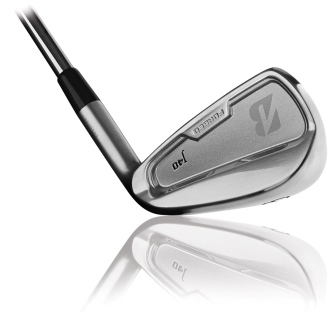 |
From a materials/manufacturing standpoint, The J40 irons are premium forged using “precision forging technology”, or PFT. During this process, the physical properties of the metal -- such as strength and flexibility -- are significantly improved. PFT also allows Bridgestone to achieve more accurate dimensions, tighter quality control standards from set to set, and a smoother overall forged surface.
The 1020 mild carbon steel that the company uses for forgings provides for the ultimate in soft feel and features conforming grooves for optimum distance and spin control.
So spin is important here as well, but we already knew that with irons.
Another unique aspect of the J40 irons line is its standard set is made up of six irons – that’s right, no three or four-iron.
Kinchen expounds: “Our research shows that better players rarely use their 3 and 4 irons anymore in a typical round. Even on TOUR, you’re starting to see players contesting major championships using a non-traditional set make-up. In many cases, those players will sub a hybrid or a more forgiving long iron in the bag. In other cases, players use the extra club to add an additional wedge to the set make-up.”
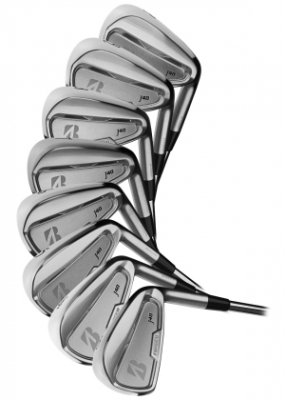 |
“It really depends on what type of player you are. If you need that typical 3 or 4 iron distance, then you can usually find a metal wood or hybrid that can fill the void.”
In all fairness, I filled the void with Mizuno MP 59 three and four irons, which I really like.
The J40 irons are fairly easy to hit, which is certainly the goal of every golf manufacturer. Kinchen says a wide range of players from TOUR pros to mid-handicappers can benefit from the Dual Pocket Cavity technology in the J40’s. “No matter your level of talent, precision forged feel with added forgiveness is an attractive quality to have in your irons. Anyone who loves and appreciates the feel and workability of a blade, but understands the importance of more MOI, will love these clubs.”
But whether the J40’s – or any other irons – are right for you can only be determined through proper fitting and, of course, trying them out.
Bridgestone recommends fitting by a trained professional. As for the fitting process itself, Bridgestone uses the same industry standards as other major OEM's which vary by fitter, but might include the use of launch monitors, varying shaft selections, lie/loft/length variances, etc. The company recommends anyone interested in being fit for Bridgestone irons visit their nearest authorized dealer that can be found at www.bridgestonegolf.com under the “Dealers” tab.
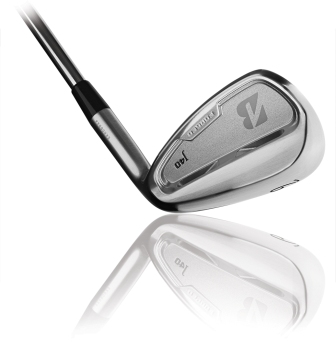 |
That’s always a good idea, especially when dealing with high-end premium equipment. If you’re going to make the investment in new clubs, you should make sure they’re right for you.
For us, we very much enjoyed trying the new Bridgestone J40 products, and would certainly recommend that you try them if you’re in the market for a new set of top-of-the-line clubs. Perhaps the most striking impression from using the J40’s is how user-friendly they are, delivering solid performance, even on less than stellar swings.
Playability builds confidence – and let’s face it, we can all use more of that.
Details:
15320 Industrial Park Blvd, NE
Covington, GA 30014
General Inquiries:
Phone: 770.787.7400
Toll-Free: 800.358.6319
Free Expert Fitting Assistance:
Toll-Free: 877.411.BFIT (2348)
Web-Based Chat: Chat Live with a Fitting Expert
Text-Based Chat: Text BFIT to 55678
Bridgestone also makes golf balls and accessories.
For more information on the company and its products, consult Bridgestone’s website: http://www.bridgestonegolf.com/
Note: The J40 445 Driver is available in 9.5, 10.5 and 12 degrees of loft and the J40 430 Driver is available in 8.5 and 9.5 degrees of loft. Both J40 Drivers come standard with a Project X® Graphite shaft and Golf Pride® grips. Custom shaft and grip options are available.
| Related Links | Comments on this article? | |
|
Maryland National Golf Club Hollow Creek Golf Club Rocky Gap Resort PB Dye Golf Club in Ijamsville Whiskey Creek Golf Club |
E-mail Jeff Rendall, Editor: jrendall@golftheunitedstates.com |












